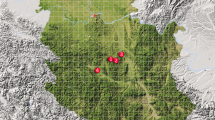Abstract
Woodlands in karnataka differ with respect to earthworm species and their densities.Lampito mauriii Kinberg,Pontoscolex corethrurus Fr. Mull., andPheretima (now,Polypheretima)elongata E Perrier are the most dominant species. Significant positive correlations were obtained between the species number, diversity and population density on one hand, and plant species number, abundance, diversity, cover and biomass on the other. A major factor for the variations in the richness of worms was accounted through vegetation-related factors. Soil organic matter had a strong influence on the worm diversity.
Similar content being viewed by others
References
Allen S E, Grimshaw H M, Parkinson J A and Quarmby C 1974Chemical analysis of ecological materials (New York: John Wiley and Sons)
Dash M C and Patra V C 1977 Density, biomass and energy budget of a tropical earthworm population from a grassland site in Orissa, India;Rev. Ecol. Biol. Sol. 14, 461–471
Habibullah A M and Ismail S A 1985 Preference to soil fractions and the effect of soil compaction on the casting and burrowing behaviour of the earthwormLampito mauritii, Indian J. Soil Biol. Ecol. 5 26–32
Kennedy C E J and Southwood T R E 1984 The number of species of insects associated with British trees. A re-analysis;J. Anim. Ecol. 53 455–478
Krishnamoorthy R V 1986Role of some tropical earthworms in nutrient cycling; inProceedings of National Symposium on organic waste utilization and vermicompost (eds) M C Dash, B K Senapati and P C Mishra. (Orissa: School of Life Sciences, University of Sambalpur) Part B pp 47–65
Lavelle P 1983 The structure of earthworm communities; inEarthworm ecology from Darwin to vermiculture (ed.) J E Satchell (London: Chapman and Hall) pp 449–466
Lavelle P 1984 The soil system in the humid tropics;Biol. Int. 9 2–27
Leather S R 1986 Insect species richness of the British Rosaceae: The importance of host range, plant architecture, age of establishment, taxonomic isolation and species-area relationships;J. Animal Ecol. 55 841–860
Lewis T and Taylor L R 1967Introduction to experimental Ecology (London: Academic Press)
MacArthur R H and MacArthur J W 1961 On bird species diversity;Ecology 42 594–598
Michael P 1984Ecological methods for field and laboratory investigations (New Delhi: Tata McGraw Hill Publ. Co. Ltd.)
Nordstrom S and Rundgren S 1973 Association of lumbricids in Southern Sweden;Pedobiologia 13 301–326
Perfecto I, Horwith B, Vandermeer J, Schultz B, McGuinness H and Santos A D 1986 Effect of plant diversity and density on the emigration rate of two ground beetles,Harpalus pennsylvanicus andEvarthrus sodalis (Coleoptera: Carbidae) in a system of tomatoes and beans;Environ. Entomol. 15 1028–1031
Pianka E R 1966 Latitudinal gradients in species diversity—a review of concepts;Am. Nat. 100 33–46
Rich S J, Andow D and Attieri M A 1983 Agroecosystem diversity and pest control: data, tentative conclusions and new research directions;Environ. Entomol. 12 625–629
Rosenzweig M L and Winakur J 1969 Population ecology of desert rodent communities, habitats and environmental complexity;Ecology 50 558–672
Snedecor G W and Cochran W G 1967Statistical methods 6th edition (Ames: Iowa State College Press)
Southwood T R E 1978Ecological methods 2nd edition (London: Chapman and Hall)
Taylor L R and Taylor R A J 1977 Aggregation, migration and population mechanics;Nature (London) 265 415–421
Whittaker R H and Woodwell G M 1968 Dimension and production relations of trees and shrubs in the Brookhaven Forest, New York;J. Ecol. 56 1–25
Author information
Authors and Affiliations
Rights and permissions
About this article
Cite this article
Krishnamoorthy, R.V., Ramachandra, S. Population structure of earthworms in woodlands of Karnataka. Proc. Indian Acad. Sci. (Anim. Sci.) 97, 355–362 (1988). https://doi.org/10.1007/BF03179545
Received:
Revised:
Issue Date:
DOI: https://doi.org/10.1007/BF03179545



